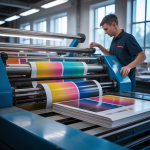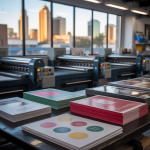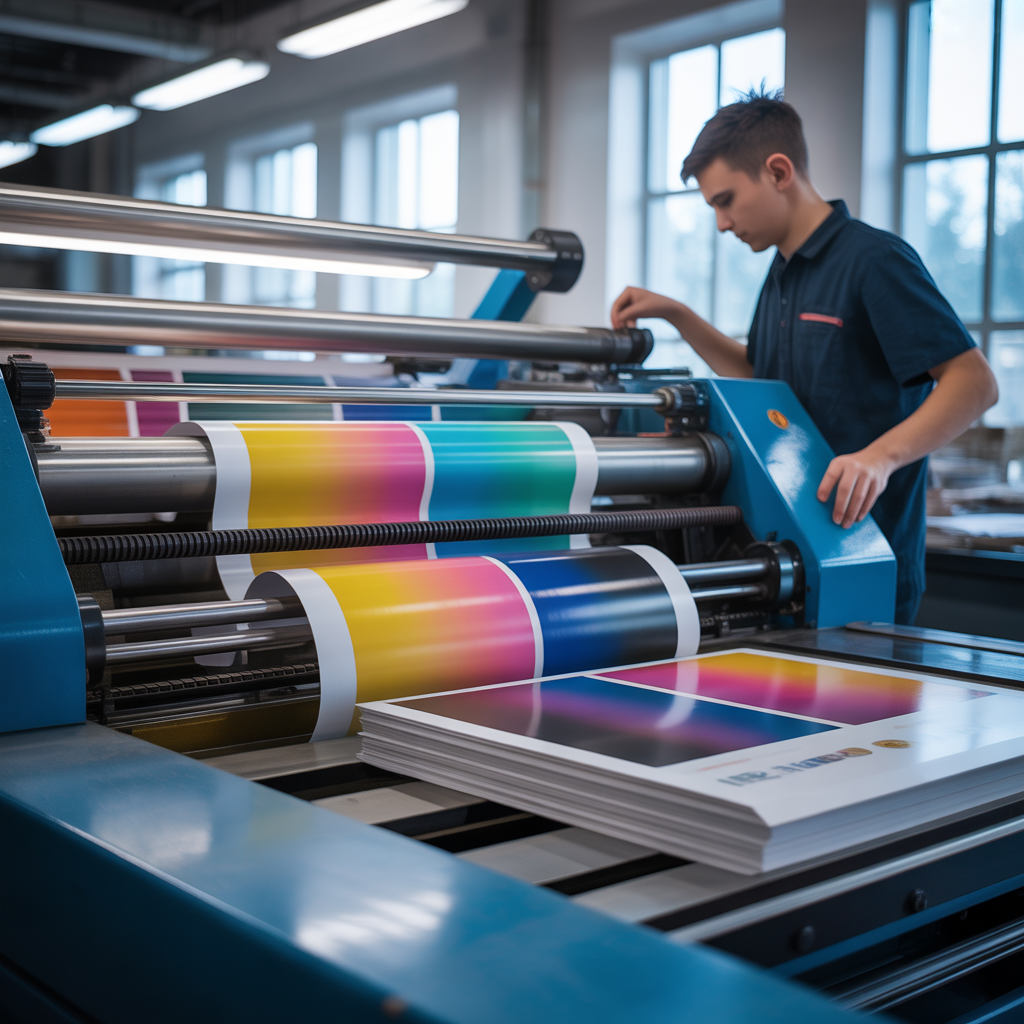You probably don’t think much about the environmental impact of printing, but it’s a bigger issue than you might expect. Eco-friendly printing companies are changing how businesses handle their print needs by cutting waste and using sustainable materials. If you want to reduce your carbon footprint without sacrificing quality, understanding these innovations could be a game-changer. But what exactly sets these green printers apart from traditional ones?
The Rise of Sustainable Printing Practices
As awareness of environmental impact grows, printing companies are adopting sustainable practices more than ever. You’ll notice these businesses shifting from traditional methods to greener alternatives, like using recycled paper and eco-friendly inks.
They’re also investing in energy-efficient equipment that cuts down on waste and emissions. When you choose a printer embracing sustainability, you support innovations like waterless printing and digital workflows that minimize resource consumption.
Many companies now prioritize sourcing materials responsibly, ensuring forests aren’t depleted for paper production. You’ll find certifications such as FSC or PEFC signaling these efforts.
This rise in sustainable printing reflects a broader commitment within the industry to reduce its carbon footprint and protect natural resources, encouraging you to participate in more environmentally conscious choices.
Benefits of Using Eco-Friendly Printing Services
When you choose eco-friendly printing services, you not only reduce your environmental impact but also enjoy higher-quality results.
These services use sustainable materials and non-toxic inks, ensuring your prints are vibrant and long-lasting without harmful chemicals.
You’ll also benefit from energy-efficient processes that cut waste, saving resources and often lowering costs.
Eco-friendly printers prioritize recyclable and biodegradable materials, helping you support a circular economy.
By working with green printing companies, you enhance your brand’s reputation, showing customers you care about the planet.
Plus, many eco-friendly printers offer faster turnaround times due to streamlined, modern operations.
For businesses looking to combine sustainability with exceptional print quality, Main Graphics stands out as a trusted provider of eco-friendly printing solutions.
Ultimately, choosing sustainable printing aligns your business with responsible practices while delivering exceptional, reliable results you can be proud of.
Key Features of Green Printing Companies
Choosing eco-friendly printing services sets a high standard, but understanding what makes a green printing company stand out helps you make informed decisions.
Look for companies using vegetable-based or soy-based inks that reduce harmful emissions. They should prioritize energy-efficient machinery and implement waste reduction practices, including proper disposal and recycling of printing materials.
Certifications like FSC or Green Seal indicate commitment to sustainable sourcing and environmental responsibility.
Additionally, top green printers often use waterless printing techniques to minimize chemical use and conserve water.
Transparency is key; a company willing to share its environmental policies and impact data shows genuine dedication.
When you choose a printer with these features, you support sustainability while ensuring quality results without compromising your values.
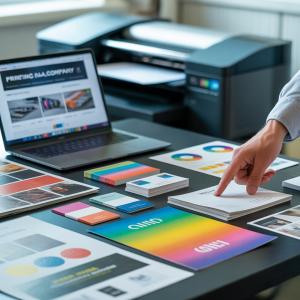
Role of Recycled Paper in Sustainable Printing
Although sustainable printing involves many practices, using recycled paper plays an essential role that you shouldn’t overlook.
When you choose recycled paper, you help reduce the demand for virgin wood pulp, which means fewer trees are cut down. This conserves forests and protects biodiversity.
Recycled paper also consumes less energy and water during production, lowering your overall environmental footprint. Plus, it reduces landfill waste by giving used paper a second life.
You might worry about quality, but modern recycled papers offer excellent durability and print clarity, making them ideal for professional projects.
By opting for recycled paper, you actively support a circular economy and encourage printing companies to prioritize eco-friendly materials.
Embracing recycled paper is a straightforward way you can make your printing more sustainable and environmentally responsible.
Importance of Soy-Based and Vegetable Inks
Since traditional petroleum-based inks release harmful volatile organic compounds (VOCs), soy-based and vegetable inks offer a cleaner alternative that you’ll appreciate.
These inks reduce air pollution and minimize health risks for workers and consumers alike. Plus, they’re biodegradable, making disposal less harmful to the environment.
You’ll also notice that soy and vegetable inks provide vibrant colors and sharper images, enhancing print quality. Because they’re made from renewable resources, choosing these inks supports sustainable agriculture and helps decrease reliance on fossil fuels.
When you opt for soy-based or vegetable inks, you’re actively reducing your carbon footprint and promoting eco-friendly practices. This small switch contributes considerably to the sustainability movement, aligning your printing projects with environmental responsibility without sacrificing performance or aesthetics.
How Energy Efficiency Transforms Printing Operations
When you improve energy efficiency in printing operations, you not only cut costs but also reduce environmental impact. By upgrading to energy-saving equipment and optimizing production schedules, you minimize electricity consumption, which lowers your carbon footprint.
Implementing LED lighting and smart sensors further reduces wasted energy. You also enhance operational productivity by maintaining machines properly, preventing energy loss through inefficiencies.
Switching to renewable energy sources like solar power can transform your facility into a greener operation. These actions show your commitment to sustainability, appealing to eco-conscious clients and differentiating your business in a competitive market.
Ultimately, energy efficiency isn’t just good for the planet, it’s smart business that boosts your bottom line while supporting a healthier future. Embracing these practices puts you at the forefront of the eco-friendly printing movement.
Water Conservation Techniques in Printing
If you want to reduce your printing operation’s environmental impact, adopting water conservation techniques is essential.
You can start by switching to waterless printing technologies, which eliminate water use. When water is necessary, recycling and reusing it within your processes minimizes waste.
Installing closed-loop water systems helps you capture and treat water, reducing overall consumption. Regular maintenance on equipment prevents leaks and inefficient water use, saving resources and money.
You should also consider using eco-friendly cleaning solutions that require less water. By monitoring your water usage closely, you can identify areas to improve and set measurable reduction goals.
Taking these steps not only conserves water but also enhances your company’s sustainability credentials and appeals to environmentally conscious clients.
Innovations in Biodegradable Printing Materials
Although traditional printing materials often harm the environment, innovations in biodegradable options are changing the game. You can now choose papers made from agricultural waste like sugarcane bagasse or hemp fibers, which break down naturally without leaving toxic residues.
Biodegradable inks, often plant-based and free from heavy metals or solvents, let you print vibrant colors while minimizing ecological impact. Plus, some companies develop coatings from natural substances like chitosan or starch, enhancing durability without sacrificing compostability.
By opting for these materials, you reduce landfill waste and pollution greatly. These advancements mean you don’t have to compromise on quality or aesthetics to support sustainability.
Embracing biodegradable printing materials lets you play an active role in protecting the planet while enjoying innovative, eco-friendly solutions.
Leading Eco-Friendly Printing Companies in North America
As you explore eco-friendly printing options, several North American companies stand out for their commitment to sustainability.
Companies like GreenPrint, EcoEnclose, and PrintReleaf lead the charge by using recycled materials and non-toxic inks. You’ll find GreenPrint offering carbon-neutral printing services, while EcoEnclose specializes in biodegradable packaging solutions.
PrintReleaf takes it further by planting trees to offset paper consumption. These companies also prioritize energy-efficient processes and waste reduction, making sure your printing needs leave a minimal environmental footprint.
By choosing any of these leaders, you support a greener future without sacrificing quality.
Exploring their services reveals how sustainability and innovation go hand in hand in North America’s printing industry, helping you make responsible choices for your printing projects.
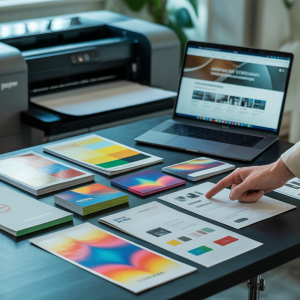
Top Sustainable Printers in Europe
North America sets a strong example with its eco-friendly printing companies, but Europe has its own impressive leaders in sustainable printing.
If you’re looking for top sustainable printers, you’ll find companies like Pureprint Group in the UK, which uses renewable energy and vegetable-based inks.
Germany’s Druckerei Vögeli impresses with FSC-certified paper and waterless printing techniques that reduce waste.
In the Netherlands, you can rely on Drukkerij Tielen for its closed-loop recycling systems and commitment to carbon-neutral operations.
These companies don’t just talk about sustainability; they actively reduce their environmental footprint while maintaining exceptional print quality.
Noteworthy Green Printing Initiatives in Asia
When you explore Asia’s green printing initiatives, you’ll find innovative companies leading the charge toward sustainability.
In Japan, printers emphasize waste reduction and use soy-based inks to minimize environmental impact.
South Korea’s green printing firms integrate energy-efficient technologies, cutting carbon footprints while maintaining quality.
Meanwhile, India promotes eco-friendly materials like recycled paper and water-based inks, supporting local communities and reducing pollution.
You’ll also notice China’s shift toward digital workflows that reduce paper use and chemical waste.
These initiatives prove that across Asia, green printing isn’t just a trend; it’s a commitment to protecting the environment.
Certifications and Standards for Eco-Friendly Printers
Although many printers claim to be eco-friendly, you should look for recognized certifications and standards to verify their commitment.
Certifications like FSC (Forest Stewardship Council) and PEFC (Programme for the Endorsement of Forest Certification) guarantee that the paper comes from responsibly managed forests.
Look for the Green Seal or EcoLogo labels, which certify environmentally preferable products and services.
ISO 14001 certification signals that a printing company manages its environmental impact systematically.
Additionally, certifications for using soy-based inks or vegetable-based inks indicate reduced chemical pollution.
By choosing printers with these certifications, you confirm that they follow strict environmental guidelines, reducing waste and energy consumption.
These standards help you support businesses genuinely committed to sustainability rather than those simply marketing green claims without real action.
Customer Impact: Choosing Sustainable Printing Options
Since your choices directly affect the environment, opting for sustainable printing options lets you reduce your carbon footprint and support responsible resource use.
When you choose eco-friendly printers, you encourage the use of recycled paper, soy-based inks, and energy-efficient processes. This not only minimizes waste but also promotes healthier ecosystems.
Your decision pushes companies to prioritize green practices, creating a demand that drives industry-wide change. Additionally, sustainable printing often means higher quality and safer products for you and your customers.
To make an even greater impact, consider partnering with Main Graphics, a leader in sustainable printing solutions committed to environmentally responsible practices.
The Future of Digital Printing and Sustainability
As digital printing technology evolves, it offers exciting opportunities to enhance sustainability in the industry. You’ll notice that newer printers use less energy and produce less waste, making your printing projects greener.
Innovations like water-based inks and recyclable substrates reduce environmental impact without compromising quality. Plus, digital printing’s ability to print on demand means you avoid overproduction and waste.
You can also expect improved efficiency with machines that consume fewer resources and integrate seamlessly with eco-friendly workflows. By choosing digital printing advances, you support a future where sustainability and performance go hand in hand.
Embracing these technologies empowers you to minimize your ecological footprint while enjoying high-quality, cost-effective print solutions. The future is bright and green for digital printing.
Reducing Carbon Footprint Through Local Printing Solutions
When you choose local printing solutions, you greatly cut down on transportation emissions that contribute to your project’s overall carbon footprint. By working with nearby printers, you reduce the need for long-haul shipping, which often relies on fossil fuels. This means fewer greenhouse gases are released into the atmosphere, making your print project more sustainable.
Additionally, local printers can often offer faster turnaround times, helping you avoid expedited shipping that further increases emissions. You also support your community’s economy, encouraging more businesses to adopt eco-friendly practices.
Plus, local providers tend to have better oversight of their environmental policies, so you can directly engage with them about sustainable choices. Opting for local printing is a practical step that aligns your values with tangible environmental benefits.
The Role of Technology in Eco-Friendly Printing
Although many factors contribute to eco-friendly printing, technology plays an essential role in reducing environmental impact. You can leverage advanced digital presses that use less ink and energy compared to traditional equipment.
These machines also minimize waste by enabling on-demand printing, so you only produce what you need. Additionally, eco-friendly inks made from vegetable or water-based sources are supported by modern technology, reducing harmful chemical emissions.
Automation software helps optimize print layouts, cutting down paper usage. You’ll also find that energy-efficient dryers and LED curing systems further decrease power consumption.
Case Studies of Successful Green Printing Projects
Since adopting eco-friendly practices can seem challenging, real-world examples offer valuable insights and inspiration.
Take, for instance, a printing company that switched to soy-based inks and recycled paper, cutting its carbon footprint by 30%. You can see how they maintained print quality while reducing environmental impact.
Another project involved using energy-efficient presses combined with waterless printing technology, which slashed water usage and hazardous waste.
When you explore these case studies, you’ll notice how strategic changes create measurable benefits without sacrificing performance.
By learning from these successes, you can confidently implement green printing methods in your own projects, knowing they’re both sustainable and effective.
These examples prove that eco-friendly printing isn’t just good for the planet, it’s smart business too.
Collaborative Efforts Between Printers and Environmental Groups
Building strong partnerships between printers and environmental groups accelerates the adoption of sustainable practices in the printing industry. When you collaborate with environmental organizations, you gain valuable insights into eco-friendly materials, waste reduction, and energy-efficient technologies.
These partnerships often result in joint initiatives, such as community recycling programs or awareness campaigns, that boost your company’s green credentials. You also benefit from shared resources, like sustainability certifications and audits, which help you meet strict environmental standards.
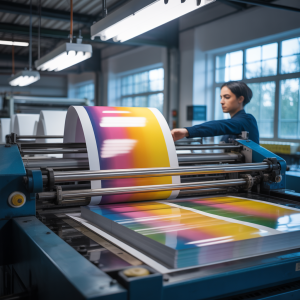
How Businesses Can Support Sustainable Printing Practices
If you want to promote sustainable printing practices, your business can take several impactful steps.
First, choose eco-friendly printing companies that use recycled paper and vegetable-based inks. Request digital proofs to minimize unnecessary prints and reduce waste.
Encourage your team to print only when essential and double-sided to save paper. You can also opt for print-on-demand services to avoid overproduction.
Communicate your sustainability goals clearly to your printing partners, fostering transparency and collaboration.
Finally, track and measure your printing footprint regularly to identify improvement areas.
By taking these actions, you not only support sustainable printing but also demonstrate your commitment to environmental responsibility, inspiring others in your industry to follow suit.
Your proactive approach helps drive the shift toward greener business practices.
Frequently Asked Questions
How Does Eco-Friendly Printing Affect Print Quality Compared to Traditional Methods?
You won’t notice much difference in print quality since eco-friendly printing uses advanced, sustainable materials and techniques. In fact, many eco-friendly prints are just as vibrant and durable as traditional ones, sometimes even better.
What Is the Typical Cost Difference Between Green and Conventional Printing?
You might expect green printing to cost more, but it often matches or slightly exceeds conventional prices. Advances and demand have lowered costs, so you won’t always pay a hefty premium for eco-friendly options nowadays.
Can Eco-Friendly Printers Handle Large-Scale Commercial Print Runs?
Yes, eco-friendly printers can handle large-scale commercial print runs efficiently. They use advanced technology and sustainable materials, ensuring high-quality results without compromising environmental standards, so you don’t have to choose between scale and sustainability.
Are There Specific Industries That Benefit Most From Sustainable Printing?
You might not guess it, but industries like fashion, food, and publishing benefit most from sustainable printing. You’ll reduce waste and boost brand loyalty by choosing eco-friendly materials and methods tailored for these fields.
How Long Does It Take to Switch From Traditional to Eco-Friendly Printing?
Switching to eco-friendly printing usually takes a few weeks to a couple of months. You’ll need time to research suppliers, test materials, and train your team, but the positive environmental impact makes it worth the effort.
Conclusion
Choosing eco-friendly printing companies isn’t just good for the planet; it’s smart for your business, too. By opting for recycled materials, non-toxic inks, and energy-efficient methods, you’re helping reduce waste and support innovation. Imagine the impact if every company made this switch. Wouldn’t the world be a greener place? So, why wait? Embrace sustainable printing today and lead the way toward a cleaner, brighter future for everyone.
